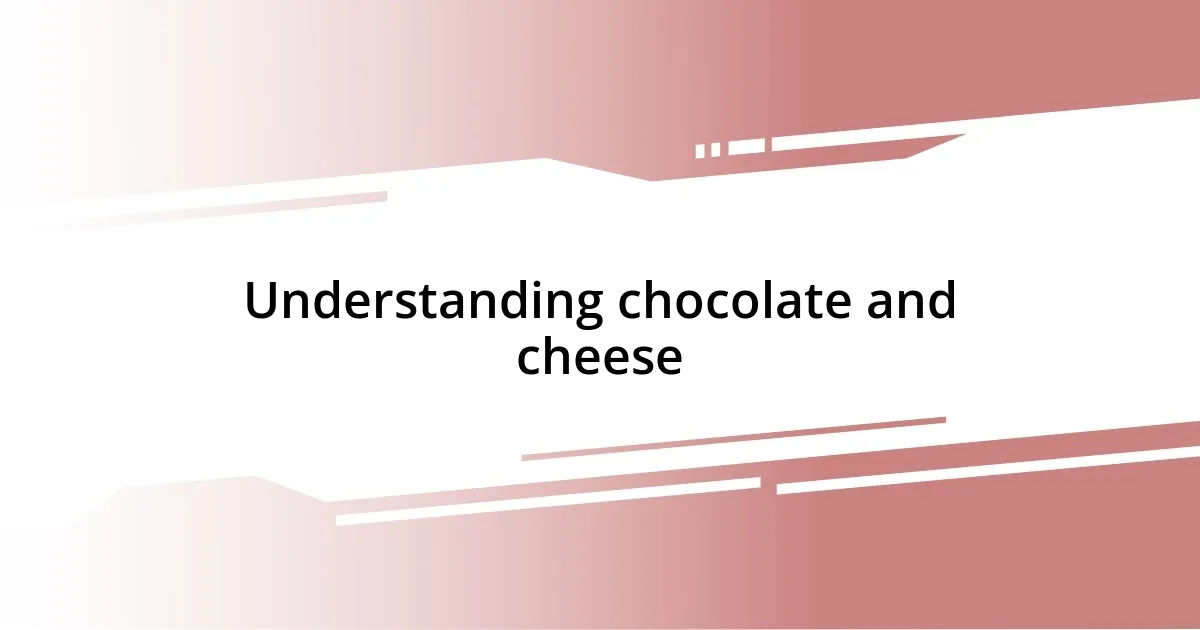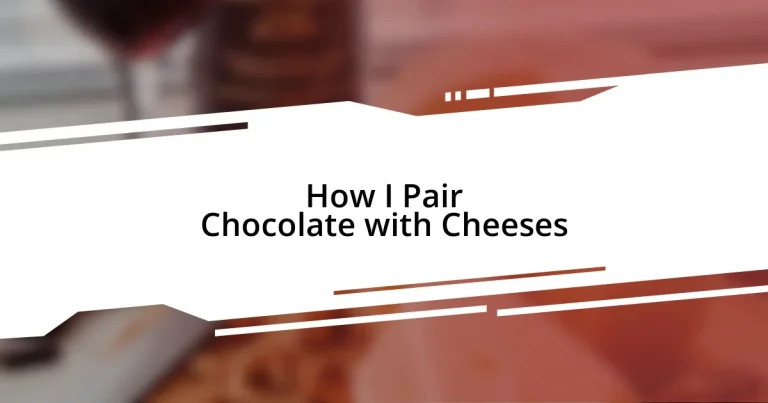Key takeaways:
- Pairing chocolate and cheese involves understanding flavor dynamics, where contrasts can enhance the tasting experience—such as tangy goat cheese with smooth milk chocolate.
- Choosing the right chocolate type (dark, milk, or white) is crucial, as it influences which cheeses will complement the flavors best.
- Presentation and atmosphere play a significant role in enhancing the tasting experience, encouraging engagement and creativity during pairings.
- Accompaniments like fresh fruits, nuts, and sweet drizzles can elevate pairings, adding unexpected layers of flavor and complexity.

Understanding chocolate and cheese
When I think about chocolate and cheese, I often recall a gathering with friends where we decided to experiment with pairings. The creamy richness of a Brie paired beautifully with a dark chocolate, enhancing both the product’s flavors while keeping the experience playful. How interesting is it that both chocolate and cheese evolve through the fermentation of different ingredients, leading to such varied textures and tastes?
Understanding the dynamics between chocolate and cheese really dives into the science of flavors. Both can range from sweet to savory; the right combination can create a delightful juxtaposition. I’ve often marveled at how a tangy goat cheese can contrast with the smooth sweetness of milk chocolate—it’s like they dance together on your palate, wouldn’t you agree?
Moreover, each cheese has its own personality, much like chocolate, which can be nutty, fruity, or floral. I remember attending a tasting where a blue cheese’s sharpness cut through a rich chocolate ganache, creating a surprising and perfect match. It’s moments like these that reveal how understanding the fundamental characteristics of each can lead to unforgettable pairings.

Choosing the right chocolate types
When it comes to choosing the right chocolate types, I find that both the cocoa content and flavor profile play pivotal roles. For instance, dark chocolate, with its higher cocoa content, typically pairs well with strong, tangy cheeses like Roquefort. I remember trying this combination during a cheese festival, where the boldness of the chocolate perfectly complemented the pronounced flavors of the cheese, creating a symphony of tastes that lingered in my memory long after the event.
On the other hand, milk chocolate is often more versatile, thanks to its creaminess and sweetness. It can beautifully enhance the flavors of milder cheeses like Camembert or Gouda. I once shared a milk chocolate and Gouda pairing at a family dinner, which sparked conversations about childhood memories and indulgences—such is the magic of pairing!
Lastly, white chocolate, despite its classification, offers a gentle sweetness and is often overlooked. It pairs surprisingly well with soft, fresh cheeses like ricotta or mascarpone. I recall a delightful brunch where we served a spread that included white chocolate-covered strawberries alongside ricotta cheese, which brought out a light and refreshing element. It’s these little surprises in pairing that make the exploration of chocolate and cheese so delightful.
| Chocolate Type | Best Cheese Pairing |
|---|---|
| Dark Chocolate | Roquefort |
| Milk Chocolate | Camenbert |
| White Chocolate | Ricotta |

Selecting compatible cheese varieties
Selecting the right cheese varieties is a delightful journey that unlocks the full potential of chocolate pairings. When experimenting, I lean towards cheeses with distinct textures and flavor profiles that can either complement or contrast the chocolate. Each pairing becomes a unique experience, much like discovering a hidden gem at a market. The thrill of unearthing a fantastic combination makes me eager to share it with others.
Here are some excellent cheese varieties to consider:
- Aged Cheddar: Its sharpness can enhance the depth of dark chocolate.
- Mascarpone: Creamy and mild, it pairs beautifully with both white and milk chocolate.
- Brie: The creaminess of Brie mellows the intensity of dark chocolate, creating a wonderful balance.
- Gorgonzola: This blue cheese’s pungent notes work surprisingly well with sweet chocolate.
- Havarti: With its smoothness and subtle flavor, it complements a variety of chocolates, making it a versatile choice.
In my experience, gathering a few different cheeses and chocolate types for a tasting offers the best insights. I remember selecting a creamy goat cheese for a cozy evening, trying to find that perfect match with a hint of dark chocolate. The result? A wonderfully complex harmony that took our taste buds on a whimsical ride, and I couldn’t help but smile knowing we had uncovered something special together.

Exploring flavor profiles together
Pairing chocolate and cheese is essentially an exploration of flavors that complement each other, creating a delightful tapestry for the palate. One time, I decided to host a small get-together focused solely on this pairing. As we sampled different combinations, I noticed how the nutty undertones of a well-aged Gouda beautifully enhanced the rich cocoa notes of a dark chocolate bar, sparking effusive discussions about the flavors we were experiencing. Isn’t it fascinating how food can bring people together, creating shared moments over delightful discoveries?
When tasting chocolate and cheese, I often think about balance. I recall attending a gourmet workshop where we paired a tangy blue cheese with a smooth milk chocolate. The initial shock of contrasting flavors morphed into an extraordinary harmony, similar to watching a beautifully choreographed dance. Could it be that the contrasts are just as essential as the complements in this culinary journey? Each bite served as a reminder that exploration can sometimes lead to unexpected but joyous outcomes.
Delving into flavor profiles, I’ve often found something magical in unexpected combinations. Once, I paired spicy chocolate with a creamy Brie. The spice elevated the cheese’s rich texture while the Brie mellowed the chocolate’s intensity. As I tasted this combination, I couldn’t help but wonder how many more extraordinary pairings were out there waiting to be discovered. Each exploration of chocolate and cheese unfolds a story of taste—and I love being part of that narrative, inviting others to join me on this delicious adventure.

Techniques for pairing effectively
When I dive into chocolate and cheese pairings, I always focus on contrasting textures to keep things interesting. Think about how a firm, crumbly cheese can play off a velvety, rich chocolate. One of my favorite nights involved a luscious dark chocolate meeting a sharp, aged gouda. The review from my friends? A unanimous delight that transformed the evening into a flavorsome adventure, leaving us all asking, “What other combinations can we uncover?”
A technique that’s served me well is considering the intensity of flavors. After a long day, I brought some creamy Camembert and filled a plate with assorted chocolate pieces. The experience was incredible! I reflected on how the rich creaminess of the cheese softened the robust dark chocolate, creating a beautiful and easy-going balance. It made me think: isn’t it fascinating how some foods just complement each other perfectly, reflecting the beauty of contrasts?
Intentional juxtaposition of flavors is vital to crafting memorable pairings. I remember a quirky evening where I took a playful approach, pairing a spicy chili chocolate with a mild, briny feta. At first, it seemed like a wild idea, but the interplay of the spicy heat and the cheese’s cooling effect was nothing short of revelatory. It prompted me to ask myself, “Why not embrace bold choices in flavor?” Those surprising pairings often lead to the most unforgettable culinary experiences, igniting curiosity and desire for our next tasting adventure.

Tips for serving and presentation
When it comes to serving chocolate and cheese, presentation can make all the difference. I remember once preparing a stunning platter featuring a variety of cheeses and chocolate squares, enhancing the visual appeal with fresh fruits and nuts. Did you know that the colors on the plate can evoke certain appetites? I noticed my guests gravitating towards the prettiest arrangements, eager to try what looked the most delectable.
Creating an inviting atmosphere is just as important as the food itself. For one gathering, I decided to dim the lights and use candles to set the mood, turning our tasting into a cozy event. I found that not only did it heighten the experience, but it also prompted everyone to share their thoughts and discoveries more openly. What could be more enjoyable than diving into rich flavors while surrounded by warm ambiance?
Lastly, I always encourage my guests to engage with the pairing process actively. Instead of simply serving the chocolate on a plate, I set out bowls with different chocolates and cheeses, inviting everyone to mix and match at their own pace. This hands-on approach fosters discussions about tastes and textures. Can you think of a better way to encourage creativity than letting others explore their combinations? It sparked laughter and surprising favorites, reminding me that the best experiences often arise from a little experimentation and shared joy.

Enhancing the experience with accompaniments
Accompaniments can elevate a chocolate and cheese tasting to a new level. I remember once serving a creamy blue cheese alongside a rich, dark chocolate, and then adding a drizzle of honey on the side. The sweetness of the honey added an unexpected layer of complexity. Isn’t it remarkable how a simple addition can transform the whole experience?
Fresh fruits are another fantastic companion. One evening, we had some juicy pears and tart apples alongside a delightful aged cheddar paired with a caramel chocolate. The bright acidity of the fruits cut through the cheese’s richness beautifully. Each bite felt exciting and refreshing, prompting me to think about how nature’s flavors can enhance any culinary journey.
Don’t overlook nuts, either! A night spent with friends was truly unforgettable when I introduced roasted almonds to my chocolate and cheese platter. The crunchiness contrasted with the smooth textures of both chocolate and cheese, adding an interesting twist. Wouldn’t you agree that the right accompaniments not only complement the main event but also make the entire experience more memorable?














